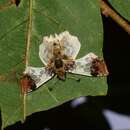en
names in breadcrumbs


Abantis is an Afrotropical[2] genus of skipper butterflies.[1] They are also known as the paradise skippers.[1] Their imagos are generally attractive with bold or colourful wing and/or body markings. They occur in either forest or savanna, and several species are very localized or thinly distributed.[3] The territorial males are encountered more often than the females. Males engage territorial intruders, and are prone to very rapid and high flight, while females display more relaxed flight habits, closer to the ground.[4] Plants of several families serve as food plants, and only one egg is oviposited per plant. The larva is pale and spotted to varying degrees, and pupates inside a leaf shelter drawn together by silk threads.[4]
Abantis is an Afrotropical genus of skipper butterflies. They are also known as the paradise skippers. Their imagos are generally attractive with bold or colourful wing and/or body markings. They occur in either forest or savanna, and several species are very localized or thinly distributed. The territorial males are encountered more often than the females. Males engage territorial intruders, and are prone to very rapid and high flight, while females display more relaxed flight habits, closer to the ground. Plants of several families serve as food plants, and only one egg is oviposited per plant. The larva is pale and spotted to varying degrees, and pupates inside a leaf shelter drawn together by silk threads.